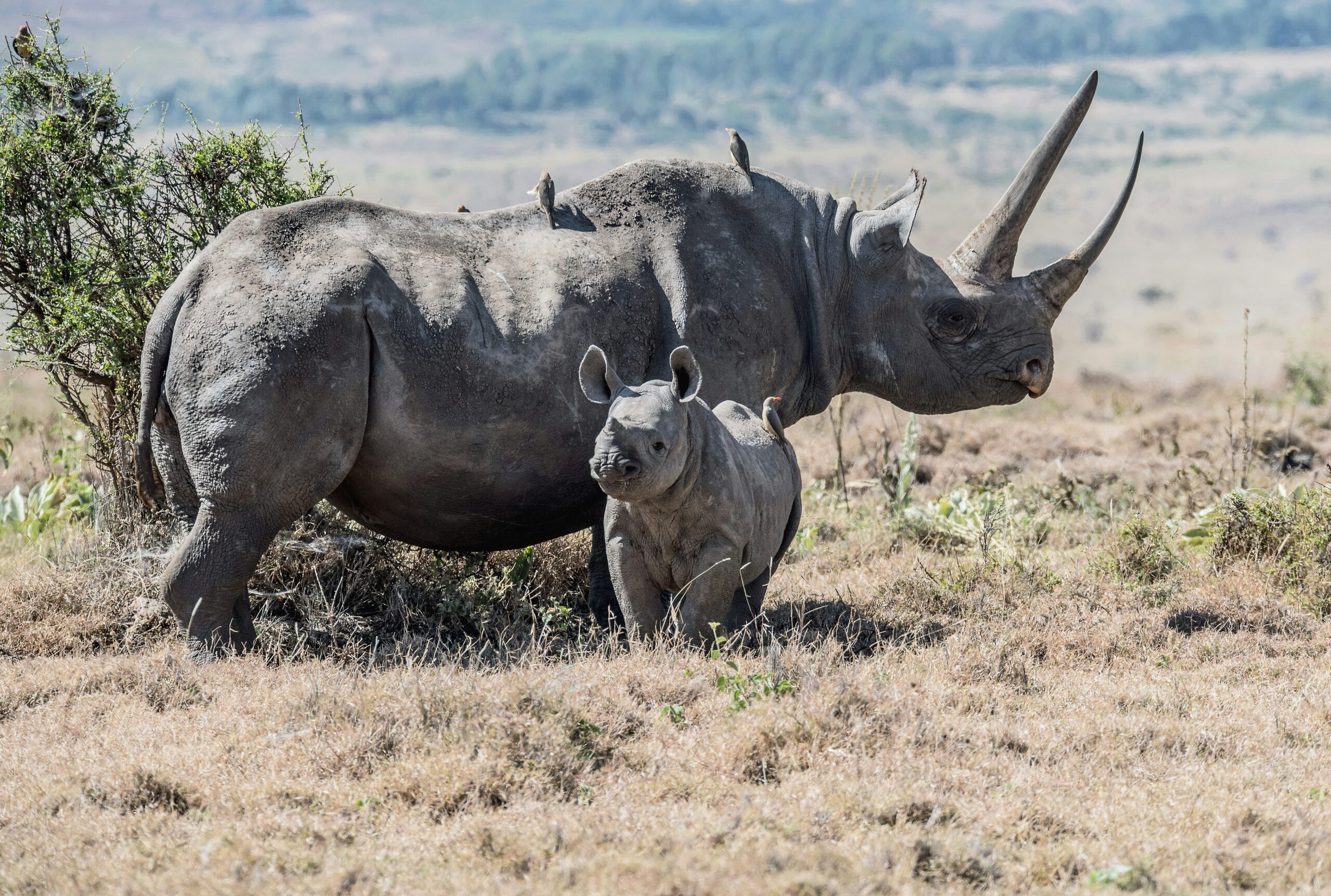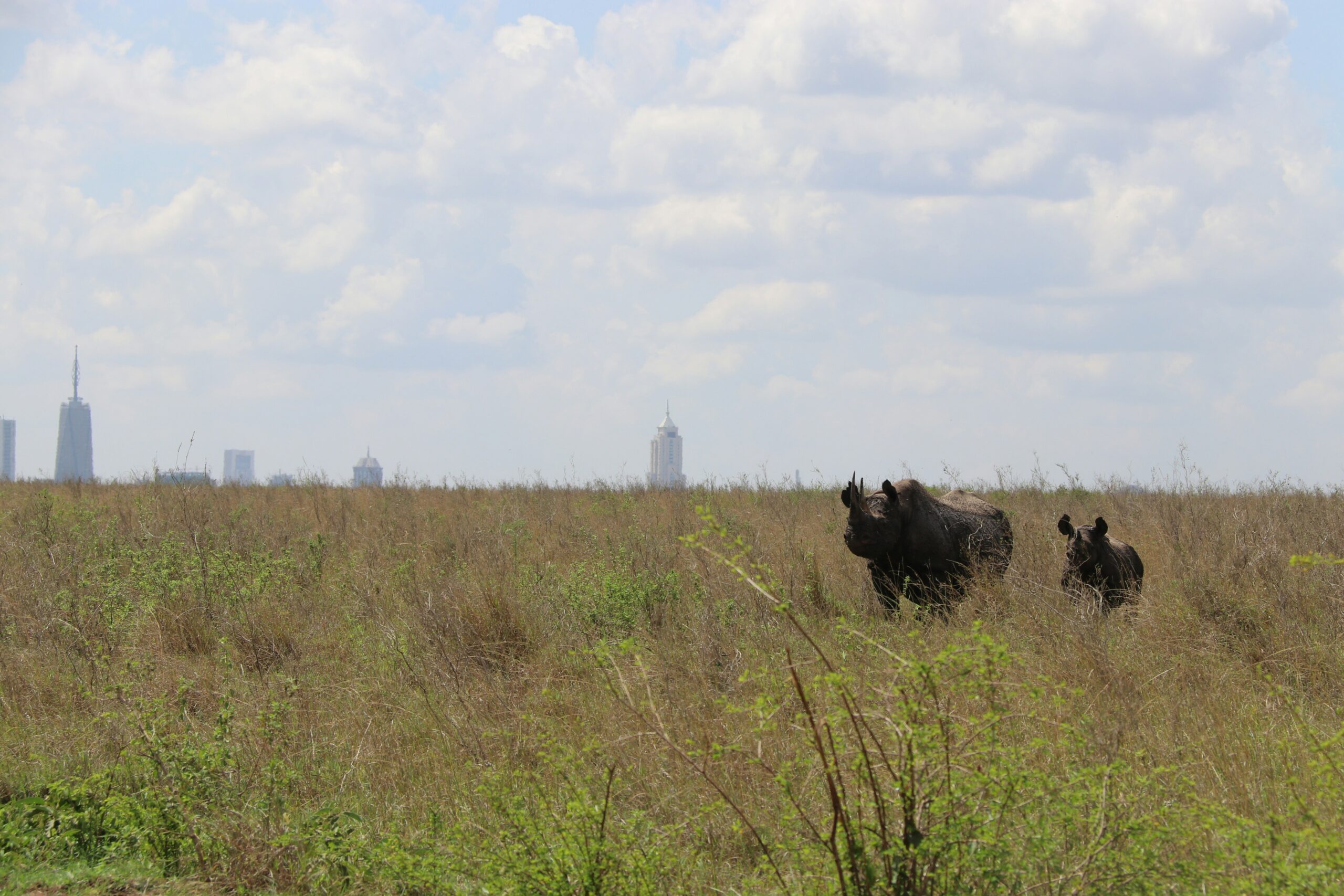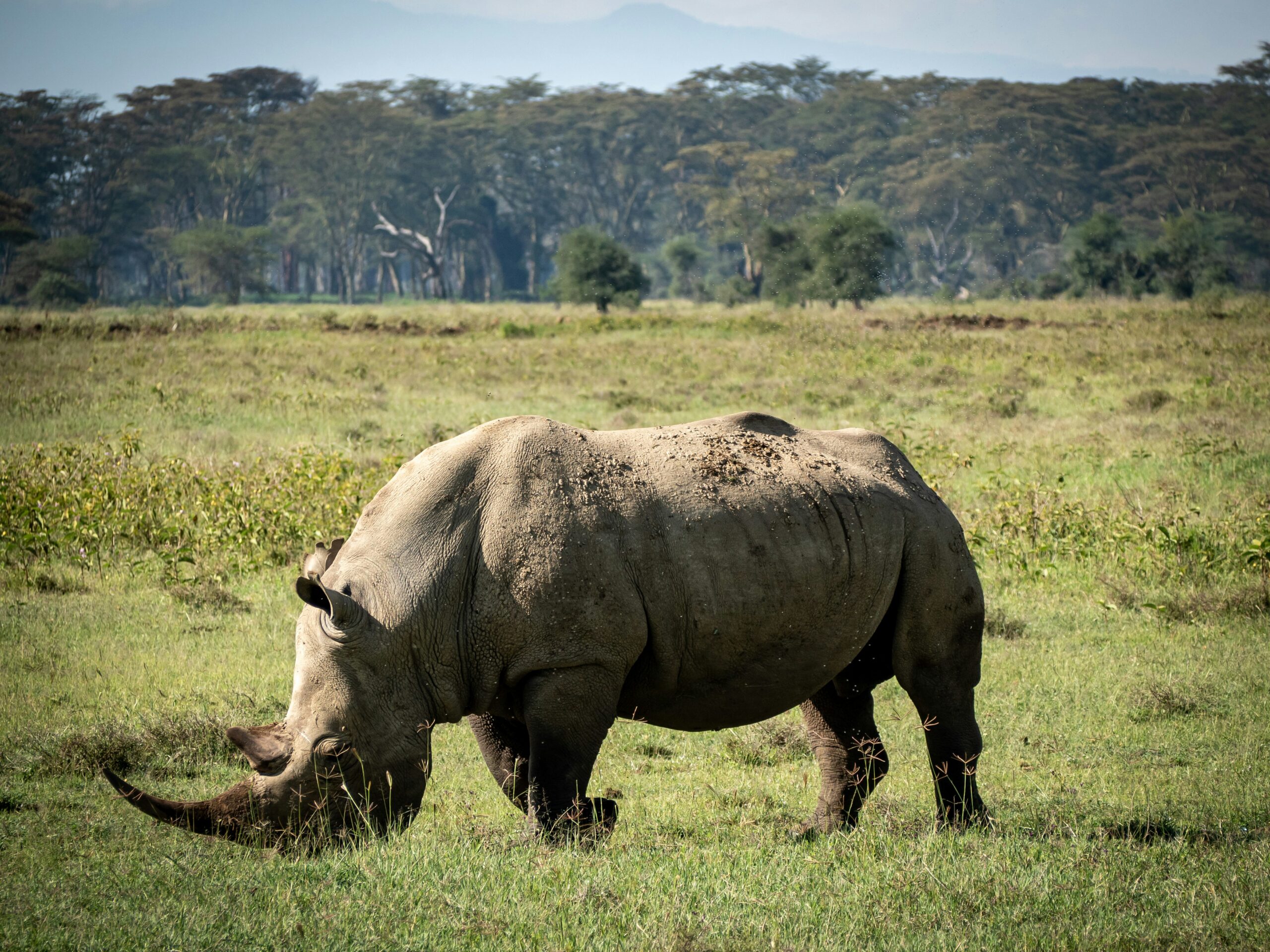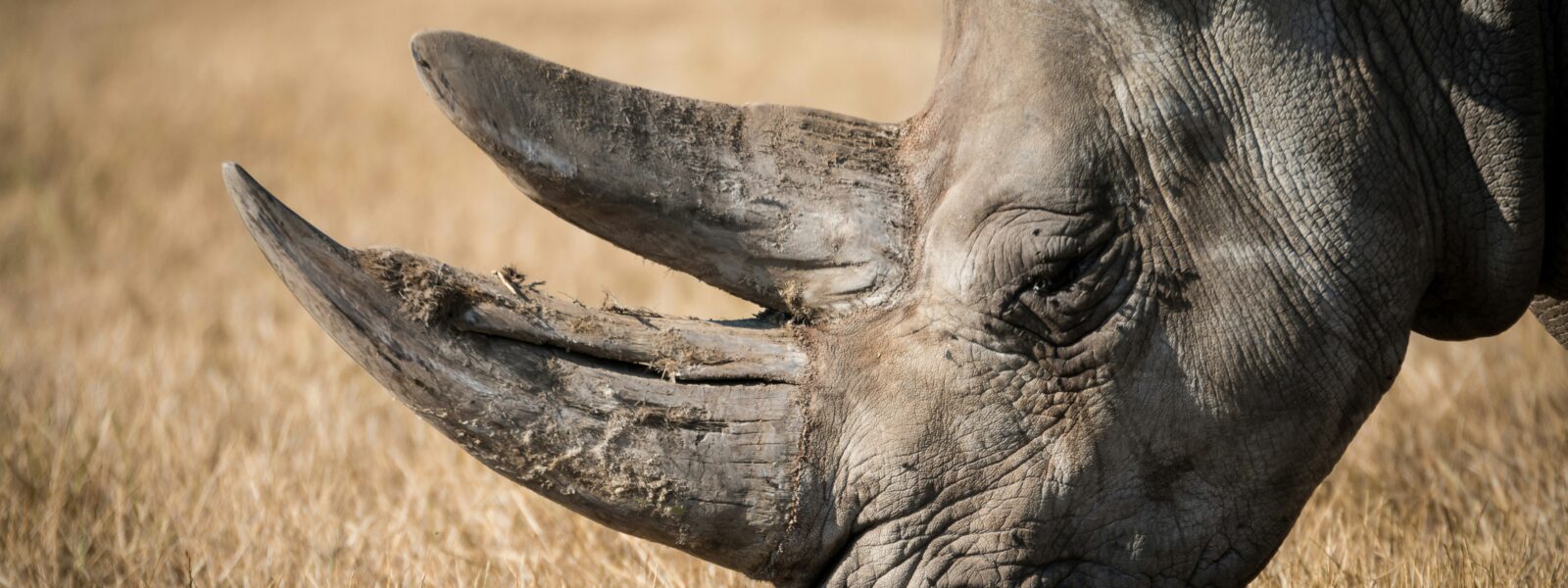Rhinos are iconic herbivores found in protected areas across Kenya, which is home to a total of 1,977 rhinos, including 1,004 Eastern black rhinos, 971 white rhinos, and the world’s last 2 northern white rhinos, both under close protection in Kenya. The country stands as a global leader in rhino conservation, thanks to its unwavering commitment to habitat preservation, strong anti-poaching measures, and community engagement. Kenya’s tireless efforts have not only stabilized rhino populations but also positioned the nation at the forefront of wildlife protection in Africa and beyond.
Many people believe the difference between the white and black rhino lies in their colour, but the real distinction is in their size, lip shape, and feeding habits, the white rhino is larger with a wide, square-shaped lip for grazing on grass, while the black rhino is smaller with a pointed, hooked lip designed for browsing shrubs and trees.
Where can I spot Rhinos in Kenya?
Lewa Conservancy: Kenya’s Premier Rhino Tracking Haven

Lewa Conservancy, set against the stunning backdrop of northern Kenya, spans 62,000 acres of protected wilderness and stands as a shining symbol of wildlife conservation. Home to over 273 black and white rhinos, Lewa shelters an impressive 14% of Kenya’s total rhino population, making it one of the most important rhino sanctuaries in the country. With animals relocated from 15 different sanctuaries, this thriving haven offers one of the most thrilling and intimate rhino tracking adventures in Africa. A visit to Lewa isn’t just about spotting these magnificent creatures up close it’s a chance to step into a conservation success story, where every footstep supports the future of endangered species in one of Kenya’s most scenic and biodiverse landscapes.
Nairobi National Park

Nairobi National Park stands as one of Kenya’s most remarkable wildlife conservation areas, uniquely located just a short drive from the bustling capital. It plays a critical role in the protection of both black and white rhinos, offering a safe haven for these iconic and endangered species. The park is especially renowned for its successful black rhino breeding program, which has contributed significantly to the population recovery efforts in the country.
Dedicated conservation teams work tirelessly to monitor each rhino using advanced tracking systems, helping to deter poaching and ensure the animals’ safety. Their efforts are complemented by round-the-clock patrols and strict surveillance measures. For visitors, Nairobi National Park provides one of the best opportunities to view rhinos in the wild, with well-planned game drive routes and knowledgeable guides enhancing the experience.
Ol Pejeta Conservancy: Where Hope Lives for Rhinos

In the heart of Nanyuki lies the 360 km² Ol Pejeta Conservancy one of Africa’s most inspiring conservation success stories. It is globally renowned as the home of the last two remaining northern white female rhinos, Najin and Fatu, a living symbol of both the fragility and resilience of wildlife in the face of extinction.
But Ol Pejeta’s impact goes far beyond these two gentle giants. It is also home to over 165 critically endangered black and southern white rhinos, making it the largest black rhino sanctuary in East Africa. With round-the-clock security, advanced monitoring, and a strong focus on community engagement, the conservancy sets the gold standard for rhino protection. Ol Pejeta isn’t just a place to visit it’s a place to be inspired. From unforgettable safari experiences to up-close encounters with conservation in action, it offers a rare chance to witness the fight to save a species.
Lake Nakuru National Park: A Protected Rhino Stronghold
 Established as a rhino sanctuary in 1984, Lake Nakuru National Park spans 188 km² and plays a vital role in Kenya’s rhino conservation efforts. Nestled around the picturesque Lake Nakuru in the Great Rift Valley, the park is fully enclosed by an electric fence strategically installed to guard against poaching and ensure the safety of its precious wildlife.
Established as a rhino sanctuary in 1984, Lake Nakuru National Park spans 188 km² and plays a vital role in Kenya’s rhino conservation efforts. Nestled around the picturesque Lake Nakuru in the Great Rift Valley, the park is fully enclosed by an electric fence strategically installed to guard against poaching and ensure the safety of its precious wildlife.
Lake Nakuru is home to around 150 rhinos, with approximately 80% being southern white rhinos and 20% critically endangered black rhinos. The sanctuary provides a secure, well managed habitat that supports both species’ breeding and growth, making it one of the best places in Kenya to spot rhinos in the wild.
In addition to rhinos, the park is a haven for flamingos, pelicans, lions, leopards, and endangered Rothschild’s giraffes offering visitors a truly diverse and rewarding safari experience.
Solio Ranch: Kenya’s Leading Rhino Breeding Sanctuary

Nestled just 22 km from Nyeri, Solio Ranch, also known as Solio Game Reserve, spans over 19,000 acres of pristine wilderness. As one of the first private conservancies in Africa dedicated solely to rhino conservation, Solio has earned its reputation as the most successful rhino breeding program in Kenya.
Home to over 250 black and white rhinos, Solio plays a crucial role in restoring rhino populations across the country. Its carefully managed habitat, intense anti-poaching measures, and expert veterinary care have created ideal conditions for rhino breeding and protection. Many rhinos from Solio have been relocated to restock other national parks and conservancies across Kenya. What sets Solio apart is not just the numbers, but the unwavering commitment to conservation excellence. In this tranquil, private reserve, visitors can witness large crash of rhinos grazing together an extraordinary and rare sight in the wild. Solio Ranch stands as a shining example of what focused, private conservation efforts can achieve, making it a must-visit for wildlife lovers and conservation enthusiasts alike.
Frequently Asked Questions About Rhinos
- What is the role of the rhino’s horns?
Rhinos use their horns for protection, fighting rivals, digging for water or roots, and breaking branches.
- What are rhino horns made of?
Rhino horns are made of keratin the same protein found in human hair and nails.
- How many species of rhinos are there?
There are five species of rhinos: two in Africa (Black and White rhinos) and three in Asia (Indian, Javan, and Sumatran rhinos).
- How long do rhinos live?
Rhinos can live up to 35–50 years in the wild, and sometimes longer in protected environments like zoos or sanctuaries.
- How fast can rhinos run?
Rhinos can run surprisingly fast up to 50 km/h about 30 mph, despite their large size.

